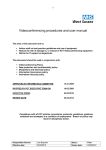Download User Guide - Exchange Data International
Transcript
Worldwide Adjustment Factors User Guide www.exchange-data.com V2.4 January 2014 Exchange Data International Adjustment Factors – User Guide Contents Overview .................................................................................................................................... 3 Format ........................................................................................................................................ 3 File Name Convention ........................................................................................................... 3 Record Format ....................................................................................................................... 4 Timing ........................................................................................................................................ 6 Option flag .................................................................................................................................. 7 Price Values ............................................................................................................................... 7 Relationship ............................................................................................................................... 7 Applying the adjustments ........................................................................................................... 8 Tracking the adjustments ....................................................................................................... 8 Negative Factors.................................................................................................................... 9 Factors of 1 ............................................................................................................................ 9 Reissuing adjustments ..........................................................................................................10 Cancelling adjustments .........................................................................................................11 Appendix 1 – Applying the adjustments, example .....................................................................12 Support .....................................................................................................................................14 Contact Information ...................................................................................................................15 2 Exchange Data International Adjustment Factors – User Guide Overview Adjustment factors are generated using price data and corporate action data supplied by Exchange Data International (EDI) and foreign exchange data supplied by Electronic Information Solutions (EIS). The following events/corporate actions are supported: Bonus De-merger Return of Capital Call Distribution Rights Capital Reduction Dividends Subdivision Consolidation Entitlement (Offer) One of the principal uses of adjustment factors is to back adjust EOD (end of day) per-share price data so that the price series can be graphed with the effect of any events (bonus, rights, consolidation, etc) “factored” into the earlier prices. Once adjusted meaningful comparisons can be made between a recent price and an earlier price, e.g. comparing a recent price of 15 against an earlier price of 20 it would appear that the security has lost 25% of its value however, after adjusting the earlier price for the 2 for 1 split (factor = 0.5), that happened between the two prices, you can see that security has actually increased in value by 50%. All “per-share” series, including prices, earnings per share, dividends per share, assets per share, cash flow per share, etc. need to be adjusted before meaningful conclusions can be drawn about growth rates, trends, etc. Format File Name Convention Adjustment files follow a similar naming convention to EDI’s price files. Basically the country code followed by an underscore, then the MIC followed by an underscore, then “AJ” followed by the six character date, yymmdd, followed by sequence number, if more than one file, then “.txt”. For example LSE adjustment files, for 1st Apr 2010, would be named: - GB_XLON_AJ100401.txt - GB_XLON_AJ100401_02.txt - GB_XLON_AJ100401_03.txt - GB_XLON_AJ100401_04.txt 3 Exchange Data International Adjustment Factors – User Guide In the above example the “_04” file is the most recent file and completely replaces all previous files. Each time an adjustment file is created it uses the most recent price file information and most recent corporate action information making earlier adjustment files obsolete. Adjustment file updates happen regularly, for many reasons, including receipt of unconfirmed price file the receipt of confirmed price file, for yesterday, today and tomorrow, etc. The last adjustment file update for today will happen when the first price file for tomorrow (business day) is received, therefore when downloading adjustment files always download yesterday’s adjustment file with today’s adjustment file. 1. On receipt of today’s unconfirmed price file, the last adjustment file update for yesterday (last business day) will be generated, an interim update for today’s adjustment file will be generated and the first adjustment file for tomorrow (next business day) will be generated. 2. On receipt of today’s confirmed price file, an interim update for today’s adjustment file will be generated and an interim update for tomorrow’s (next business day) adjustment file will be generated. NOTE: no update for yesterday’s (last business day) adjustment file will be generated. 3. On receipt of tomorrow’s unconfirmed price file, the last update for today’s adjustment file will be generated, an interim update for tomorrow’s adjustment file will be generated and the first adjustment file, for the next day, will be generated. 4. Adjustment file updates will be discarded if nothing changed between recent update file and previous update file. Record Format Each adjustment record consists of the following fields, in a tab-separated format: Secid: Security identifier as used in both EDI’s price files (“secid”) and corporate actions (“SecID”). This field can be used to link the adjustment record to the price file record and the corporate action record. IssuerName: Name of issuer for the security being adjusted (sourced from corporate action). SectyCD: Type of security being adjusted (sourced from corporate action) – o EQS: Equity o DR: Depository Receipt o WAR: Option/Warrant ISIN: ISIN Code (sourced from corporate action) SedolTM: SEDOLTM code (sourced from corporate action) 4 Exchange Data International Adjustment Factors – User Guide Status: Adjustment record status – o “A”: Apply o “R”: Rescind (remove/reverse), indicates that this adjustment was been cancelled or reissued after an adjustment record has already been published. Note this can happen years after the ex-date. For further information refer “Rescinding the Adjustment” section. Market: MIC code (sourced from corporate action) Symbol: code used in price files (“pricefilesymbol”), closest match to LocalCode in corporate action and often the same as the exchange’s ticker symbol. ExDate: ex-date/effective date of the event in the format of yyyymmdd Reason: 2 byte reason code – o 01: Rights in same class o 11: Distribution o 02: Rights in different class o 13: Bonus same class o 03: Entitlement in same class o 14: Bonus different class o 04: Entitlement in different class o 16: Capital Reduction o 05: Subdivision o 17: Cash Dividend o 06: Consolidation o 18: Script dividend same class o 09: De-merger o 20: Script dividend different class o 10: Capital Return o 21: Capital Call Factor: adjustment factor Detail: text description of the event, also contains flags in square brackets, e.g. [OPTION=1]. EventType: code for type of event (sourced from corporate action ~ specifically the code for the type of corporate action) – o BON: Bonus o DIV: Dividend o CALL: Call o ENT: Entitlement o CAPRD: Capital Reduction o RCAP: Return of Capital o CONSD: Consolidation o RTS: Rights o DMRGR: De-merger o SD: Subdivision o DIST: Distribution EventID: Unique identifier for this event (sourced from corporate action) ResSedolTM: resultant SEDOLTM (sourced from corporate action) USCode: US Code (sourced from corporate action) PrimeEx: primary exchange (sourced from corporate action) Closed: previous close price used in calculation of factor where applicable ResISIN: resultant ISIN (sourced from corporate action) ResLocal: resultant local code (sourced from corporate action) Sentiment: market sentiment ~ the market’s reaction to the event. Simply the previous close divided by today’s open. 5 Exchange Data International Adjustment Factors – User Guide Errors: hexadecimal value indicating any errors encountered in calculating the factor (when any of the following happen the factor is set to “1”. This is a bit flag where each bit has the following meanings: o $0000: No errors detected. o $0001: No recent (within 6 months) close price found. If processing primary exchange and no recent (within 6 months) price available then code set to $0001 and defaults to using older, more stale, close price. If not primary exchange then will attempt to get recent close from primary exchange, if available then will set error code $0020 else will set error code $0001 and use stale price if available. o $0002: No open price found. o $0004: Currency mismatch and unable to convert. o $0008: Issue price was equal to or greater than the stock price. o $0010: Issue was in the class of an option and therefore impact of little significance and/or difficult to determine. o $0020: Last price from PrimeEx used o $0040: Open price from PrimeEx used o $0080: Factor from PrimeEx used Note: SEDOL is a registered trademark of London Stock Exchange plc. Timing Adjustment factors are provided on the ex-date, of the event, except: 1. when the corporate action is incomplete (missing core fields like “Ratio New”, etc.) in which case the factor will be provided as soon as the corporate action becomes complete after the ex-date or 2. the factor calculation requires the open price of a security that has not traded yet in which case it will generate a factor as soon as the security trades. The first generation of factors for a particular ex-date will happen close of market the day before the ex-date and the last generation of factors, for a particular ex-date, will happen close of market the day after the ex-date. Every time a price file is received, confirmed or unconfirmed, during this period, an adjustment factor file will be generated. Each time an adjustment factor file is generated it is compared to the previous file, of same date, and if different it is published (filename incremented and loaded up to EDI’s servers) if it is not different it is not published. For example: - Exdate-1 CC_MIC_AJyymmdd.txt - Exdate+0 CC_MIC_Ajyymmdd_02.txt (if different to previous file) - Exdate+1 CC_MIC_Ajyymmdd_04.txt (if different to previous file) 6 Exchange Data International Adjustment Factors – User Guide Option flag Often the shareholder is given the option of taking the event in a few different ways, for example a dividend might be paid in USD or GBP and the shareholder needs to choose how they wish to receive it, alternatively it might be paid as cash or script or a combination of both, again the shareholder needs to choose how they wish to receive the dividend. Also de-mergers and distributions might have different options for the shareholder to consider. In all these cases an option flag is set in the Detail field, e.g. “[OPTION=1]”, detailing that this is option 1 or option 2 or option 3, etc. Where there are multiple options you will need to choose one of the options and use that one. If unsure, which option to use, then use [OPTION=1]. RULE: Never apply multiple adjustments with same ex-date, EventID and different option flags. Price Values - “Close” is the physical close price (as disseminated by the exchange) provided the security traded today otherwise the close is the valuation close (if provided by the exchange) else it is the last traded price irrespective of how many days ago that might be. - “Last” is simply the previous close, irrespective of whether it is a price or a value. - “Open” is today’s open price as disseminated by exchange. Relationship Generally there is a one to one relationship to the underlying corporate action however in a few circumstances this is not true: 1. When a dividend delivers both cash and script the corporate action specifies this as a DivType of “Both”. This is split into two separate adjustment records, one for the cash component and the other for the script component, which can be recombined later as desired. When this happens the OPTION flag will be set to the same in each case. RULE: Where you see a script dividend adjustments and a cash dividend adjustment with the same EventID, ExDate & Option you can optionally recombine the two by multiplying the two factors together. 2. When an event is the linked to a previous event they will be combined into a single adjustment record. For example in Stockholm they often return cash to shareholders in the form of free redemption rights (RDR) followed by a return of capital on those redemption rights. When this happens only one adjustment record will be generated for both corporate actions. 7 Exchange Data International Adjustment Factors – User Guide Applying the adjustments Decide which type of adjustments you want to apply (DIV, BNS, etc) then use the Reason field to access only those adjustments and ignore the others. Prior to using any adjustment factor check that no other adjustment record has the same EventID and ExDate, if it has then check the OPTION flag ~ you should only use one of the options for the same EventID and ExDate. This is common when a shareholder has the choice of taking a dividend in multiple currencies and cash or script selection. Refer description on OPTION flag for further information. WARNING: USCOMP adjustments are a special case where the same event can come in from multiple exchanges; therefore, in addition to the above, you will need to select one exchange’s events. For example, a composite security might be listed on the AMEX, NASD & NYSE, when it does a subdivision, you will have 3 subdivisions adjustment records ~ you will need to choose one. Compare the factor to the sentiment value, if available, they should be roughly the same if they are significantly different then the factor should be used with caution or even modified to bring it closer to sentiment (this is purely your prerogative). Multiply all historical prices, up to but not including the ex-date, by the factor. Optionally divide all historical volumes, up to but not including the ex-date, by the factor for consolidations and subdivisions only. For an example of this see Appendix 1. Be prepared for corrections to come through, at a later date, in the form of rescinded adjustment records, in which case you need to reverse or remove the original adjustment. Tracking the adjustments When applying the adjustments you need to be able to identify a specific adjustment in a database or which adjustments have been applied to the price data, when applying directly. Using the date by itself is not sufficient because there might be multiple adjustments for same security on same date (ex-date). In each case a key is required to uniquely identify the event. For a database of events, for specific exchange, the key would comprise of Date (ex-date) + Reason + DIVPERIOD (dividends ONLY). Therefore when deleting, inserting or replacing, you would use the key to see if a corresponding event already exists. When using a database that contained all adjustments from all exchanges you would probably use a key like: Exch (PrimeEx) + Code (Local or Sedol or SecID or ISIN) + Date (ex-date) + Reason + DIVPERIOD (dividends ONLY). 8 Exchange Data International Adjustment Factors – User Guide When adjusting price data directly and there is a need to ensure that any particular event is not applied multiple times, it is necessary to track which events have been applied. Usually this would only be necessary on the most recent date and previous days can be ignored. Either way the key, in this case, would comprise of Code (ticker code or SecID) + Date (ex-date) + Reason + Status + DIVPERIOD (dividends ONLY). Status is necessary because you need to know that a rescinded event has been applied or not (rescinded events, like active events, should not be applied more than once). Tracking adjustments is especially important when using the interim adjustment files, rather than just the last published interim file, which is the “official” file for that day. Adjustment records, in interim files, can change significantly, including being in earlier interim files and gone in later ones (event cancelled during the day). Suggested methodology: 1. Download latest incremental file and save to disk. 2. Compare recently downloaded file to previously downloaded file, of same date, and ascertain what is missing and handle accordingly. You can either update your database directly, at this point, or copy the missing record into the recently downloaded file and change the status to "R". 3. Use recently downloaded file to update database. Negative Factors These are rare however can happen, for example when a DIV (dividend) is paid that is greater than the share price, on the ex-date, or a RCAP (return of capital) that is also greater than the share price, on the ex-date. This type of event can happen when a fund is being closed down and final distributions made in form of a DIV or RCAP. Factors of 1 A factor of “1” can either be a valid factor or default factor where one could not be calculated. Default factors are 1.0 because this is mathematically neutral and can be used as placeholders when factors cannot be calculated. Reasons for not being able to calculate factors include: 1. No stock close price when a stock close price required. 2. No issue open price when an issue open price required. 3. Unable to perform currency conversion when required. For exact nature of reason why a factor could not be calculated refer to Errors field. 9 Exchange Data International Adjustment Factors – User Guide However, factors of “1” are valid in following circumstances: 1. When a RTS (rights) or ENT (entitlement) issue makes the issue available at a price that is equal to or above the current stock price (issue price > stock price). 2. When a company does a RTS (rights) or ENT (entitlement) issue of options with an exercise date far in the future the impact may be of little significance or difficult to determine due to uncertainty. 3. CAPRD (Capital reduction) of 1 for 1. Reissuing adjustments Adjustments will be re-issued and the original adjustment record rescinded, if any of the corporate action key fields change after the date the adjustment was first published. For example if the RatioNew or RatioOld change, after the date of first publication, then the original adjustment will be rescinded (after March 2010) and a new adjustment will be issued. NOTE: Very rarely EDI might reprocess all adjustments for a specific exchange, in which case you will be supplied via email or special FTP download all reprocessed adjustment files going back to 2007. You will need to remove all data loaded from the original adjustment files, up to the date of the reprocess, and then load all data from the newly reprocessed adjustment files. The easiest way to remove the old data from your database is by using an identifying field that specifies the prefix of the filename from which they were loaded. For example, if loading from AU_XASX_AJyymmdd.txt you would set the “File” field in your database record to “AU_XASX”. Doing this will facilitate the later removal if necessary. Reprocessed files are consolidated into a single file so one file replaces all incremental update files, for example: CC_MIC_Ajyymmdd.txt replaces all below: 1. CC_MIC_Ajyymmdd.txt 2. CC_MIC_Ajyymmdd_02.txt 3. CC_MIC_Ajyymmdd_03.txt All exchanges where reprocessed in early 2013 so history prior to 2013 should not contain any incremental update adjustment files. If you do receive history that has incremental update prior to 2013 then you have received the incorrect history ~ do not use this. 10 Exchange Data International Adjustment Factors – User Guide Cancelling adjustments Adjustments are rescinded if the original adjustment is cancelled or re-issued after the publication date (usually the exdate). Where an adjustment has been rescinded this will need to be removed/reversed out of your system. If you are loading the adjustment records into a database then you will need to remove the rescinded adjustment record from your database. If you are back-adjusting price series data then you will need to reverse the rescinded adjustment record from your price series data using the inverted factor to reverse the original adjustment. It is recommended to process rescinded adjustment records before processing any re-issued adjustment records. NOTE: During the day of publication, if an adjustment is cancelled or re-issued it is not rescinded; the change is simply reflected in the next interim file. For example, if a dividend is cancelled on the day of publication then the interim file before cancellation will contain an adjustment record for that dividend however an interim file after the cancellation will not contain an adjustment record (it is not rescinded, it is simply gone). For this reason, when using interim files it is especially important to track adjustments, see “Tracking the Adjustments”. Let’s look at a specific example. On the 12/12/2012 we published a factor for ASX:JHX dividend of 0.047746370. On the 19/12/2012 the dividend changed from 0.047746370 to 0.047465 so we cancelled the original adjustment factor record by rescinding it and published a new record based on the revised information. You would need to remove the old record from your database before loading in the new record. 11 Exchange Data International Adjustment Factors – User Guide Appendix 1 – Applying the adjustments, example Assuming you have the following adjustments for a particular security: - 2007/05/22 0.87 - 2008/09/27 0.555 - 2009/11/05 1.27 - 2010/03/03 0.666 The usual method used, to back adjust prices, is to move forward in time, i.e. start with the earliest factor and move to the most recent. This is usually the only method available when receiving a daily data feed of prices and adjustments and adjusting as they come in. The method is simple: 1. Multiply all prices prior to 2007/05/22 by 0.87. 2. Multiply all prices prior to 2008/09/27 by 0.555 (including those done in point 1). 3. Multiply all prices prior to 2009/11/05 by 1.27 (including those done in point 2). 4. Multiply all prices prior to 2010/03/03 by 0.666 (including those done in point 3). An alternative method, to back adjust prices, is to move back in time, i.e. start with the most recent factor and move to the earliest. This can only be used when bulk adjusting a large number of historical prices, however it is also the faster method. The method is slightly more complex: 1. Factor = 1 2. Multiply all prices from most recent back to 2010/03/03 by Factor 3. Factor = Factor * 0.666 4. Multiply all prices from 2010/03/02 back to 2009/11/05 by Factor 5. Factor = Factor * 1.27 6. Multiply all prices from 2009/11/04 back to 2008/09/27 by Factor 7. Factor = Factor * 0.555 8. Multiply all prices from 2008/09/26 back to 2007/05/22 by Factor 9. Factor = Factor * 0.87 10. Multiply all prices from 2007/05/21 back to earliest prices by Factor The second method is also used when the prices are stored in a database un-adjusted alongside the adjustments. When loading the prices they can be back adjusted, on the fly using the second method. 12 Exchange Data International Adjustment Factors – User Guide Table of unadjusted and adjusted prices Date 20/05/2007 21/05/2007 22/05/2007 23/05/2007 25/09/2008 26/09/2008 27/09/2008 28/09/2008 04/11/2009 05/11/2009 06/11/2009 01/03/2009 02/03/2009 03/03/2009 04/03/2009 Factor 0.87 0.555 1.27 0.666 Combined Factor 0.408404187 0.408404187 0.4694301 0.4694301 0.4694301 0.4694301 0.4694301 0.84582 0.84582 0.84582 0.84582 0.666 0.666 0.666 0.666 0.666 1 1 Unadjusted Price 57 58 52 53 55 54 53 30 32 33 32 41 41 43 44 44 28 28 Adjusted Price 23.279038659 23.687442846 24.4103652 24.8797953 25.8186555 25.3492254 24.8797953 25.3746 27.06624 27.91206 27.06624 27.306 27.306 28.638 29.304 29.304 28 28 13 Exchange Data International Adjustment Factors – User Guide Support Exchange Data International offers client support from 0800 hours – 2230 hours (GMT) Monday – Friday. Opening hours on UK bank holidays will be 1400 hours – 2230 hours (GMT) except for Christmas Day and New Year’s Day when we are closed. All queries should be sent via the online customer support centre or via email to [email protected]. Alternatively, clients can contact the support department via the main Switch Board: +44 (0)207 324 0020. EDI offers 24h phone support Monday to Friday for all its pricing services We aim to acknowledge all queries within an hour of receipt, and answer the queries within 24 hours where possible. We will send a progress report if the query is not resolved within that timeframe. We resolve around 95 percent of customer queries within 24 hours. All queries sent to our Support department are filtered and dispatched to the relevant department. An IT staff member is engaged in the communication process to resolve complicated technical issues. 14 Exchange Data International Adjustment Factors – User Guide Contact Information United Kingdom – Headquarters Exchange Data International Ltd Churchill House, 5th Floor 142-146 Old Street London, EC1V 9BW Tel: + 44 207 324 0020 Fax: + 44 207 324 0021 Jonathan Bloch, Chief Executive Officer Cell: + 44 7785 550 043 E-mail: [email protected] Kevin Brady, Executive Director Cell: + 44 7880 732 374 E-mail: [email protected] Andrew Sabourin, Business Manager Tel: + 44 207 324 0028 E-mail: [email protected] Brian James, Business Manager Tel: +44 207 324 0029 E-mail: [email protected] United States Exchange Data International Inc ® 142 West 36th Street, Room 1009 New York, NY 10018 Tel: (212) 214 0825 Fax: (212) 214 0825 Canada Exchange Data International Inc ® 4th Floor, 6500 TransCanada Service Rd Montreal, H9R 0A5 Tel: (514) 755 8469 Fax: (514) 426 6101 Michael Hyland, Business Manager USA Cell: +1 (732) 618-2854 E-mail: [email protected] David Mallette, Business Manager Canada Cell: + 1 (450) 441 3453 E-mail: [email protected] South Africa Exchange Data International 11 Midhurst Way Constantia, Cape Town 7806 Tel: +27 (0) 79 553 1370 Fax: +27 (0) 800 981 745 Matt Quigley, Business Manager South Africa Tel: +27 7955 313 70 E-mail: [email protected] Morocco Bloc A Numero 46 Lotissement Azaitoune Tikiouine, Agadir 80650 Tel: +212 528 290 255 Fax: +212 528 290 356 Said Benbihi, Office Manager E-mail: [email protected] 15



























